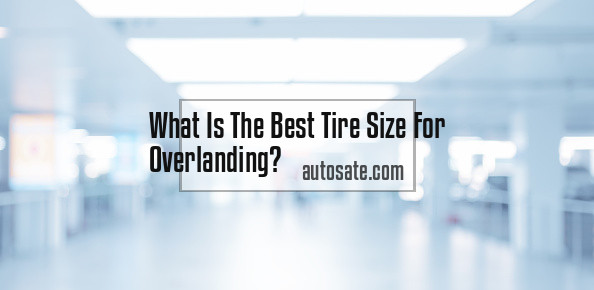Overlanding is a term used to describe a self-reliant adventure travel lifestyle. It is about exploration and discovery, and usually involves traveling to remote or seldom-visited locations.
The best tire size for overlanding really depends on the type of vehicle you are using and the terrain you’ll be traversing. A larger tire will obviously have better ground clearance and offer more traction, but it will also be heavier and create more drag on the vehicle. If you’ll be doing a lot of off-roading, a larger tire is probably the way to go. But if you’ll mostly be driving on paved roads, a smaller tire might be a better option.
Ultimately, it’s up to you to decide what tire size is best for your overlanding adventure. There are no hard and fast rules, so experiment and see what works best for you.
What Are The Pros And Cons Of Different Tire Sizes For Overlanding?
When it comes to outfitting your overlanding rig, one of the most important choices you’ll make is what size tires to run.
There are a lot of factors to consider when deciding on tire size, and there’s no one-size-fits-all answer. The best tire size for your rig will depend on a number of factors, including the type of terrain you’ll be traversing, the weight of your vehicle, and your personal preferences.
To help you make the best decision for your rig, we’ve put together a list of the pros and cons of different tire sizes for overlanding.
Smaller tires (27-29 inches):
Pros:
1. Smaller tires are typically lighter than larger tires, which can help reduce the overall weight of your vehicle and improve fuel economy.
2. They also tend to be cheaper than larger tires.
3. Smaller tires provide better maneuverability and can be helpful when navigating tight trails.
Cons:
1. Smaller tires have less ground clearance than larger tires, which can be a problem when traversing obstacles or deep water crossings.
2. They also have a smaller contact patch, which can lead to decreased traction on loose or slippery surfaces.
3. Smaller tires can be more susceptible to punctures and other damage.
Larger tires (31-33 inches):
Pros:
1. Larger tires have a larger contact patch, which provides increased traction on loose or slippery surfaces.
2. They also have more ground clearance than smaller tires, which can be helpful when traversing obstacles or deep water crossings.
3. Many people find that larger tires give their rig a more aggressive look.
Cons:
1. Larger tires are typically more expensive than smaller tires.
2. They also tend to be heavier than smaller tires, which can reduce fuel economy and increase the overall weight of your vehicle.
3. Larger tires can be more difficult to maneuver in tight spaces.
4. They can also put more strain on your vehicle’s suspension and drivetrain.
So, which tire size
Is right for you?
As we mentioned, there’s no one-size-fits-all answer. The best way to decide is to consider the type of terrain you’ll be traversing, the weight of your vehicle, and your personal preferences. Once you’ve taken all of these factors into account, you’ll be able to make an informed decision that will help you get the most out of your overlanding experience.
What Are The Tradeoffs Between A Larger Tire Size And A Smaller Tire Size For Overlanding?
When it comes to outfitting your overlanding vehicle, one of the most important choices you’ll make is tire size. Do you go with a smaller, nimbler tire or a larger, more aggressive one? Both have their advantages and disadvantages. Here’s a look at the tradeoffs between a smaller tire size and a larger one for overlanding.
Smaller Tire Size
Advantages:
1. Greater fuel efficiency. Smaller tires have less rolling resistance, which means your engine doesn’t have to work as hard to move the vehicle forward. This translates into better fuel economy.
2. More nimble handling. A smaller tire size makes your vehicle more maneuverable. This can be a big advantage when you’re driving on tight, winding trails.
3. Less weight. Smaller tires weigh less than larger ones, which helps to keep your vehicle’s overall weight down. This is important because a heavier vehicle uses more fuel and is more difficult to control.
Disadvantages:
1. Less ground clearance. A smaller tire size means less ground clearance. This can be a problem when you’re driving over obstacles or through deep mud or sand.
2. Less traction. A smaller tire size also means less traction. This can be an issue when you’re driving in slippery conditions or when you need extra traction to get up a steep hill.
3. More vulnerable to punctures. Because they have less rubber, smaller tires are more vulnerable to punctures. This can be a serious problem when you’re driving in remote areas where it’s difficult to find a service station.
Larger Tire Size
Advantages:
1. More ground clearance. A larger tire size gives you more ground clearance. This can be a big advantage when you’re driving over obstacles or through deep mud or sand.
2. More traction. A larger tire size also means more traction. This can be an issue when you’re driving in slippery conditions or when you need extra traction to get up a steep hill.
3. More rubber = more puncture resistance. Because they have more rubber, larger tires are more resistant to punctures. This can be a big advantage when you’re driving in remote areas where it’s difficult to find a service station.
Disadvantages:
1. poorer fuel efficiency. Larger tires have more rolling resistance, which means your engine has to work harder to move the vehicle forward. This translates into poorer fuel economy.
2. Less nimble handling. A larger tire size makes your vehicle less maneuverable. This can be a big disadvantage when you’re driving on tight, winding trails.
3. More weight. Larger tires weigh more than smaller ones, which can add to your vehicle’s overall weight. This is important because a heavier vehicle uses more fuel and is more difficult to control.
So,
What’s the best tire size for overlanding?
The answer depends on your individual needs and preferences. If you prioritize fuel efficiency and nimble handling, then a smaller tire size is the way to go. If you need maximum ground clearance and traction, then a larger tire size is the better choice. Ultimately, it’s up to you to decide what’s best for your overlanding vehicle.
What Are The Benefits Of A Larger Tire Size For Overlanding?
When it comes to overlanding, tire size matters. A larger tire size has a number of benefits that make it ideal for off-road adventures.
First, a larger tire size provides more ground clearance. This is important when you’re driving over rough terrain or obstacles. With more clearance, you’re less likely to bottom out or scrape your vehicle.
Second, a larger tire size gives you a wider footprint. This provides better traction and stability, both of which are crucial when driving on uneven surfaces.
Third, a larger tire size can absorb more impact. This is beneficial when driving on rough roads or over rocks and other obstacles. By absorbing more impact, your tires are less likely to suffer damage.
Fourth, a larger tire size can improve your fuel economy. This is because taller tires have a lower rolling resistance. This means that your engine doesn’t have to work as hard to move the tires, which translates into better fuel economy.
Finally, a larger tire size can improve your vehicle’s appearance. Many people feel that larger tires give a vehicle a more rugged and aggressive look.
If you’re considering a tire size upgrade for your overlanding vehicle, keep these benefits in mind. A larger tire size can make a big difference in your off-road adventures.
What Are The Drawbacks Of A Smaller Tire Size For Overlanding?
There are a few drawbacks to having smaller tires on your overlanding vehicle. First, you will have less ground clearance. This can be a problem when you are driving on rough terrain or over obstacles. Second, smaller tires can be more difficult to keep inflated at high altitudes. This can be a problem if you are planning to do any extended driving in the mountains. Finally, smaller tires can be more susceptible to punctures and other damage. This can be a problem if you are driving on rough roads or in remote areas where it may be difficult to find a replacement tire.
What Is The Best Tire Size For Overlanding In Terms Of Overall Performance?
When it comes to choosing the best tire size for overlanding, there are a few factors to consider. Overall performance is important, but so is the size of your vehicle and the type of terrain you’ll be driving on. Here’s a look at a few different tire sizes and how they might perform in an overlanding situation.
Smaller tires, such as those that are 31 inches or less, are going to be lighter and easier to maneuver. They’ll also have a lower rolling resistance, which means they’ll use less fuel. However, they might not provide as much traction or stability as larger tires.
Larger tires, such as those that are 33 inches or more, will provide more stability and traction. They’re also more likely to be able to handle deeper water crossings and tougher terrain. However, they can be more difficult to maneuver and may use more fuel.
The best tire size for overlanding really depends on your individual needs and what you’ll be using your vehicle for. If you’re driving on mostly paved roads with the occasional dirt road, a smaller tire might be a good option. If you’re planning on doing a lot of off-roading, a larger tire might be the way to go. Ultimately, it’s up to you to decide what’s best for your overlanding adventure.
Conclusion
There is no definitive answer when it comes to what is the best tire size for overlanding. However, a good starting point would be to look at tires that are 35 inches or larger. These tires will provide you with the extra ground clearance and traction you need when venturing off the beaten path.
If you’re still unclear about anything after reading this, feel free to leave a comment below about your specific question.


